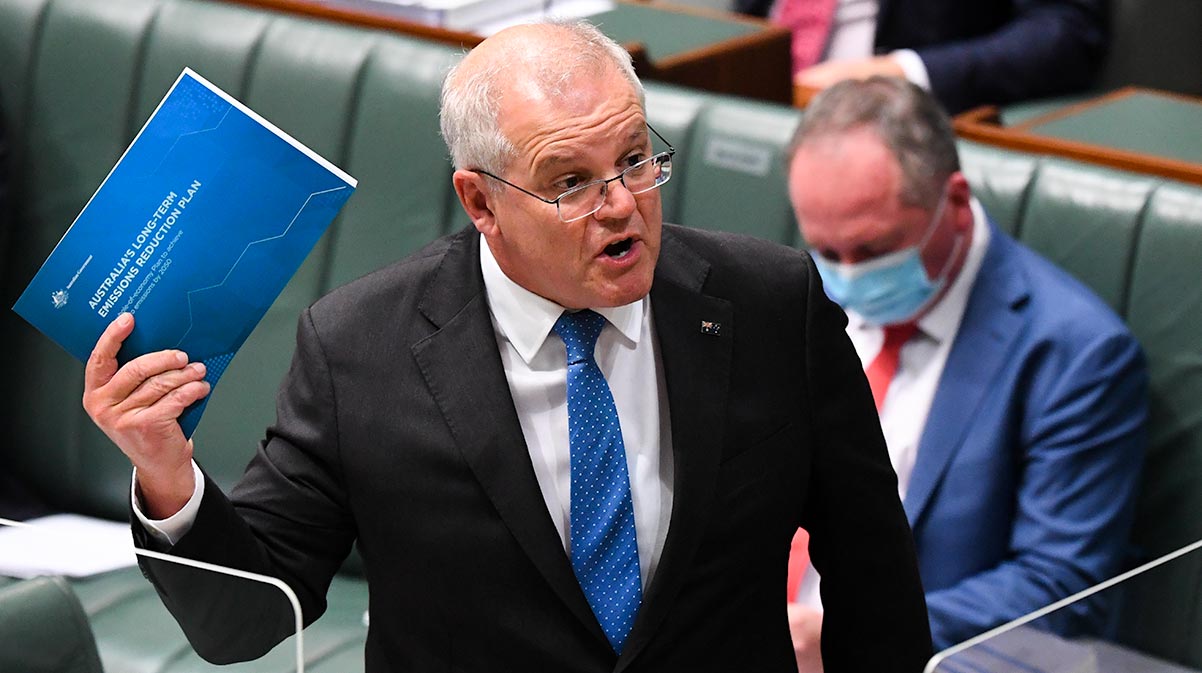The Morrison government has not been able to publish the modelling that underpins its new net zero emissions target because it hasn’t finished writing it, department officials have told a senate estimates hearing.
Deputy secretary of the Department of Industry, Science, Energy and Resources, Jo Evans, told a senate estimates hearing on Thursday that the department is still finalising a write up of the government’s modelling, and because of this, it was not in a form ready to be published.
Evans made the revelations in response to questions from Country Liberal Party senator, Sam McMahon, who asked whether it would be possible to have the modelling tabled for the senate committee.
“I can confirm that we are finalising the writing of that work. You can appreciate that it’s quite a complex set of material and as the plan was only finalised on Tuesday, we need to make sure we have written that technical workup,” Evans told the hearing.
“The actual modelling, of course, had been finalised at that point, but the write up of it, we just need to take a little bit of extra time to make sure that it’s written clearly enabled to be presented well to the Australian public.”
“We had all of the analysis finalised to inform cabinet’s consideration of the plan. But it is a complex set of work. And we’re just finalising it to make sure that we’ve got that accurate for publication,” Evans added.
The Morrison government cannot publish its net zero emissions modelling, because it hasn't finished writing it up. #Estimates pic.twitter.com/aOQcSVIxfc
— Michael Mazengarb (@MichaelM_ACT) October 28, 2021
Officials suggested that documents detailing the Morrison government’s zero net emissions plan were still being developed up until Tuesday’s announcement, with changes being made following a federal cabinet meeting on Monday evening.
Evans said that while the modelling work had been completed, it was currently detailed in technical language and contained within spreadsheets, and the department was still working to translate the modelling results into a form appropriate for public release.
Officials also confirmed that while the modelling found that a net zero target would lead to growth of the Australian economy, leaving Australia financially better off in the long-term, the modelling had not considered the economic impacts of not taking more ambitious action on climate change.
Asked about it in Question Time, prime minister Scott Morrison said the modelling would be published in “coming weeks”.
“I said on a number of occasions the government will be releasing the modelling in the next few weeks, and it will be there, along with our plans that go quite methodically about how we intend to achieve that target,” Morrison said.
Opposition leader Anthony Albanese swiftly sought to move a motion that “condemned” Morrison for “misleading the Australian parliament and Australian people by not telling them that the modelling document for their net zero commitment did not exist”.
The Morrison government used its majority in the House of Representatives to block Albanese’s motion.
On Tuesday, the Morrison government released its “plan” for its commitment to a net zero emissions target for 2050, which was largely absent of any new policy commitments and is predicated on both existing government policies and the emergence of as yet unknown technological advances.
But the government has not released the modelling that it has prepared to inform the net zero commitment, saying only that it would be released at some point in the future.
The situation has led to criticisms of the Morrison government’s plan, due to perceptions that it lacks sufficient detail and substantial uncertainty remains around how and when Australia would reduce emissions.
This uncertainty was further inflamed on Thursday, with deputy prime minister Barnaby Joyce suggesting that the Nationals had secured an agreement to carve-out methane emissions from the plan, as well as the entire agriculture sector.
The government had engaged consultancy McKinsey to complete at least part of the modelling work – for which it was paid around $6.157 million – but also engaged controversial consultancy BAEconomics to “verify” the results of modelling conducted by the department itself.
BAEconomics has previously produced highly partisan modelling that was used to attack federal Labor policies ahead of the 2019 federal election, producing results that massively exaggerated the costs of Labor’s election platform.










